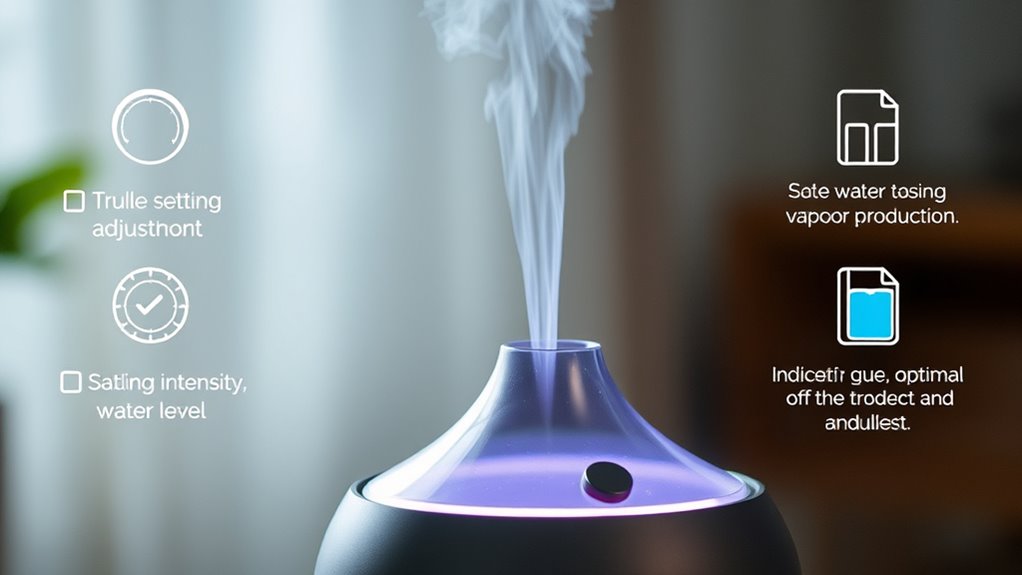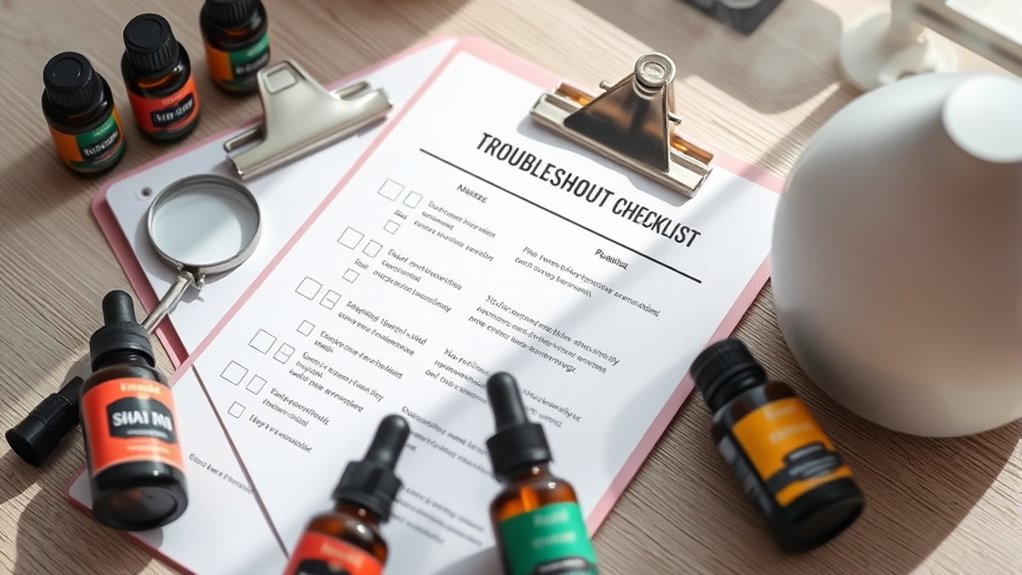To troubleshoot respiratory aromatherapy, make certain your diffuser is on a stable surface, cleaned regularly, and working at the correct settings. Use high-quality, fresh essential oils from reputable sources, and store them properly. Watch for signs of sensitivities or allergies; adjust diffuser times and ventilation as needed. Check for blockages or contaminants blocking airflow and remove any debris. If issues persist, consulting a professional can help optimize your setup—more tips await to help you troubleshoot effectively.
Key Takeaways
- Ensure proper diffuser placement, regular cleaning, and correct water/oil ratios to prevent malfunctions and optimize therapy.
- Use high-quality, properly diluted essential oils from reputable sources and store them properly to maintain potency.
- Adjust diffuser settings and monitor external factors like ventilation and air pollution to maintain effective vapor dispersion.
- Check for and remove blockages or contaminants in the diffuser to prevent uneven misting and reduce odors.
- Limit exposure time, observe reactions, and consult professionals if respiratory issues or sensitivities occur during aromatherapy use.
Ensuring Proper Diffuser Usage and Maintenance

Are you making sure your diffuser is used and maintained correctly? Proper diffuser placement is key—place it on a flat, stable surface away from windows, vents, and direct sunlight to guarantee optimal mist dispersal. Regular cleaning prevents buildup that can clog the device and affect performance. When it comes to essential oil blending, use high-quality oils and follow recommended ratios to avoid overuse or damage. Always add water first, then your selected essential oils, and avoid overfilling to prevent leaks. Check manufacturer instructions for specific maintenance guidelines, including replacing filters or cleaning nozzles. Proper usage and upkeep not only extend your diffuser’s lifespan but also ensure you get the best respiratory benefits from your aromatherapy sessions. Consulting proper diffuser maintenance practices can further enhance your experience.
Selecting the Right Essential Oils for Respiratory Support

When choosing essential oils for respiratory support, you’ll want to focus on their benefits for breathing ease. Popular options like eucalyptus, peppermint, and tea tree are often effective, but it’s important to understand their safety and proper dilution. By following best practices, you can select oils that support your respiratory health safely and effectively.
Identifying Respiratory Benefits
Ever wondered which essential oils can best support your respiratory health? To identify their benefits, focus on how they promote breathing improvement and allergy relief. Oils like eucalyptus and peppermint are known for clearing nasal passages and reducing congestion, making breathing easier. Tea tree oil offers antimicrobial properties that can soothe irritated airways and combat allergens. When selecting oils, consider their specific effects: some target inflammation, others calm coughs or improve airflow. Pay attention to your symptoms—if congestion is your main issue, choose oils known for decongestant qualities. Always verify the essential oil’s intended respiratory benefit before use. Recognizing respiratory support and selecting the right oils accordingly can significantly enhance your breathing comfort and overall health.
Popular Essential Oil Choices
Choosing the right essential oils can make a noticeable difference in supporting your respiratory health. Popular blends often include eucalyptus, peppermint, tea tree, and eucalyptus-ravintsara mixes, known for their breathing-enhancing properties. These oils are staples in aromatherapy for clear airways and relief from congestion. However, be cautious of aromatherapy myths—some believe all oils are safe in any amount, but proper use is crucial. Selecting oils with proven respiratory benefits helps ensure effective support without unnecessary risks. Focus on high-quality, pure essential oils, and consider how each blend can address your specific needs. Remember, knowing which oils work best for your symptoms will help you create an effective and enjoyable aromatherapy routine. Proper storage methods are essential to maintain the potency and safety of your oils over time.
Safety and Dilution Tips
Are you aware of how important proper dilution is when using essential oils for respiratory support? Proper dilution is crucial for essential oil safety and to prevent irritation or adverse reactions. Always follow recommended guidelines, typically diluting essential oils in a carrier oil before inhalation or topical use. Using undiluted oils increases the risk of skin sensitivity and respiratory discomfort. Keep in mind that some oils are more potent and require more careful handling. When selecting essential oils, choose those known for respiratory benefits, but never compromise on proper dilution. This dilution process ensures safe, effective aromatherapy sessions. Remember, proper dilution not only enhances safety but also maximizes the therapeutic benefits of your essential oils.
Verifying Quality and Freshness of Aromatherapy Oils

To make certain you’re getting the full benefits of your aromatherapy oils, verifying their quality and freshness before use is vital. Many Aromatherapy myths suggest that all essential oils are the same, but quality varies greatly depending on essential oil sourcing. Fresh oils retain their therapeutic properties and aroma, so check for clear, vibrant bottles and avoid oils that look cloudy or have sediment. Smell the oil; it should have a strong, pure scent without any off-putting or stale odors. Look for reputable brands that provide detailed information about their sourcing practices and testing. Properly stored oils—away from heat, light, and air—maintain their potency longer. Confirming quality guarantees you’re experiencing the true benefits of your aromatherapy experience.
Adjusting Diffuser Settings for Optimal Vapor Production

Adjusting your diffuser settings correctly is key to achieving the ideal vapor production for your space. Begin with diffuser calibration to confirm it operates at peak performance. Check if the device’s output aligns with manufacturer recommendations, making adjustments if necessary. For vapor density adjustment, modify the mist intensity or duration settings to control how much vapor is released. Increasing vapor density creates a more noticeable mist, while decreasing it prevents over-saturation. Consider the room size and ventilation when fine-tuning these settings. Proper calibration and vapor density adjustment help you maintain a consistent, comfortable environment and maximize the benefits of your aromatherapy oils. Regularly review and tweak these settings to ensure peak vapor production tailored to your personal preferences and space requirements. Incorporating AI-powered optimization techniques can further enhance your diffuser’s performance and efficiency.
Checking for Allergic Reactions or Sensitivities

While fine-tuning diffuser settings enhances vapor quality, it’s equally important to monitor how your body reacts to the aromatherapy. Pay close attention to signs of allergic reactions or sensitivities, such as sneezing, coughing, skin irritation, or breathing difficulties. If you notice any of these symptoms shortly after starting your diffuser, stop use immediately. Keep track of which scents cause discomfort, as some essential oils are more likely to trigger sensitivities. Conduct a patch test by applying a diluted oil to a small skin area before diffusing it widely. Recognizing early signs of allergic reactions helps prevent more serious health issues and ensures a safe, enjoyable aromatherapy experience. Always listen to your body and adjust or discontinue use if needed. Understanding chemical compositions of essential oils can also aid in identifying potential allergens and sensitivities.
Identifying External Factors That May Affect Efficacy

Have external factors been affecting your diffuser’s effectiveness? Environmental influences and external pollutants can reduce the benefits of your aromatherapy. These factors may interfere by contaminating the diffuser or altering how the oils disperse. To identify these issues, consider the following:
| External Influences | Potential Impact |
|---|---|
| Air pollution | Introduces pollutants that diminish efficacy |
| Humidity levels | Excess moisture can dilute scents |
| Temperature fluctuations | Affect diffusion consistency |
| Indoor pollutants | Dust, smoke, or fumes can clog diffuser |
| Ventilation | Poor airflow limits scent distribution |
Regularly check for external pollutants and environmental influences to keep your diffuser functioning properly and maximize therapeutic benefits. Additionally, maintaining a clean workspace helps prevent buildup of dust or debris that could interfere with diffuser performance.
Proper Storage of Essential Oils and Diffusers

Proper storage of essential oils and diffusers is critical to maintaining their potency and extending their lifespan. Keep essential oils in dark glass bottles, stored in a cool, dry place away from direct sunlight and temperature fluctuations. This prevents oxidation and preserves their aromatic properties, which is vital for effective aromatherapy. When it comes to diffusers, clean them regularly and store them in a sealed container to prevent dust and contamination. Remember, some aromatherapy myths suggest that blending oils can reduce their effectiveness; in reality, proper storage helps you get the most out of your blends. Additionally, integrating advanced AI processing, like the Snapdragon 8 Gen 3, can enhance the control and customization of smart diffusers through real-time AI features. By following these storage tips, you’ll guarantee your essential oils remain fresh and effective, supporting ideal respiratory benefits and accurate essential oil blending.
Recognizing and Addressing Possible Contaminants or Blockages

Contaminants and blockages can considerably impair your diffuser’s performance, so it’s crucial to recognize the signs early. Airflow obstructions often cause uneven misting or reduced output, signaling a buildup of debris or residue. Contaminant sources, such as dust, mold, or old essential oils, can also lead to clogs or unpleasant odors. Regularly inspect the diffuser for visible blockages in the air intake or nozzle. If you notice a decline in mist or a strange smell, clean the unit thoroughly. Remove any debris, wipe down internal parts, and guarantee no foreign objects are blocking airflow. Addressing these issues promptly keeps your diffuser functioning efficiently, guarantees optimal dispersion of aroma, and maintains a healthy respiratory environment. Additionally, using appropriate essential oils can help prevent residue buildup and ensure cleaner operation over time.
Monitoring Usage Frequency to Prevent Overexposure

You need to watch for signs of overuse, like headaches or respiratory irritation, to prevent overexposure. Once you notice these, it’s important to modify how often you run your diffuser. Keeping usage in check helps ensure you enjoy the benefits without any negative effects. Regular maintenance and proper ventilation are also essential for safe aromatherapy practices and adherence to safety standards.
Recognize Overuse Signs
Monitoring how often you use a product is essential to prevent overexposure, which can lead to diminishing benefits and potential health issues. Recognizing overuse signs early helps you avoid problems like symptom escalation and scent fatigue. If you notice your symptoms worsening instead of improving, it could indicate you’re overdoing it. Scent fatigue, where the aroma becomes less noticeable or becomes overwhelming, is another key indicator. Pay attention to your body’s reactions; if you start experiencing headaches, nasal irritation, or dizziness, these are signs you’re using aromatherapy too frequently. Tracking your usage and staying alert to these signs helps you maintain safe, effective inhalation. Adjust your routine accordingly to prevent overexposure and enjoy the benefits safely.
Adjust Diffuser Frequency
Adjusting how often you run your diffuser is key to preventing overexposure and maintaining its benefits. To do this, monitor your diffuser placement; avoid placing it near your face or in small, enclosed spaces, which can increase scent intensity and risks of overuse. Instead, position it in an open area at a comfortable distance. Limiting diffuser operation to 15-30 minute sessions a few times daily helps control scent intensity and reduces potential respiratory irritation. Pay attention to how your body reacts—if you notice headaches, congestion, or irritation, cut back on usage. Regularly modifying the frequency ensures you enjoy the aromatherapy benefits without overwhelming your senses or causing overexposure. Proper diffuser placement and mindful timing are essential to a safe, effective experience.
Consulting Professionals When Problems Persist

When problems persist despite your efforts, consulting professionals can provide expert insight and tailored solutions. They understand that respiratory issues often involve holistic approaches, considering both your body and environment. Professionals, such as aromatherapists or healthcare providers, can assess environmental factors like air quality, humidity, and diffuser placement that might be affecting your aromatherapy results. They can recommend adjustments or alternative treatments suited to your specific needs. If you’re still experiencing discomfort or ineffective results after troubleshooting, seeking expert advice ensures you’re not missing underlying health issues or environmental influences. Ultimately, consulting professionals helps you safely optimize your respiratory health while maintaining a balanced, holistic approach to aromatherapy.
Frequently Asked Questions
How Often Should I Replace My Diffuser or Essential Oils?
You should replace your diffuser every 6 to 12 months, depending on its lifespan and how often you use it. For essential oils, replace them when their scent weakens or after about 1-2 years to guarantee freshness. Regular cleaning extends diffuser life, while using fresh oils maintains aroma quality. Monitoring these factors helps you enjoy ideal respiratory benefits and keeps your aromatherapy experience safe and effective.
Can Respiratory Aromatherapy Cause Adverse Effects in Children or Pets?
Respiratory aromatherapy can pose risks; about 10% of adverse reactions involve children and pets. Children safety is vital, as their respiratory systems are more sensitive, and pets may react unpredictably. Essential oils like eucalyptus or peppermint can cause irritation or toxicity if ingested or inhaled in high concentrations. Always keep diffusers out of reach, use only child-safe oils, and consult your vet or pediatrician before use to prevent adverse effects.
What Are Common Signs of Diffuser Malfunction or Failure?
You’ll notice signs of diffuser malfunction like inconsistent misting, unusual noises, or the device not turning on. If your diffuser isn’t working properly, try cleaning it thoroughly, as residue buildup can cause issues. Also, check the oil quality—poor-quality oils can clog the mechanism or affect performance. Regular diffuser cleaning and using high-quality oils help guarantee it functions smoothly and prolongs its lifespan.
Are There Specific Essential Oils to Avoid for Respiratory Issues?
You should avoid essential oils that can trigger respiratory reactions, such as eucalyptus, peppermint, and tea tree, especially if you have asthma or sensitive airways. Always prioritize essential oil safety by researching each oil’s potential respiratory triggers before use. If you notice any irritation, stop using the oil immediately. Consulting with a healthcare professional can help you choose safe options, ensuring your aromatherapy experience remains beneficial and safe.
How Do I Troubleshoot Inconsistent Vapor or Scent Dispersion?
Think of your diffuser as a lighthouse guiding scent through fog. To troubleshoot inconsistent vapor or scent dispersion, start by adjusting the diffuser placement—avoid corners or vents. Make certain you’re using high-quality oils, as poor quality can cause weak vapor. Clean the diffuser regularly to prevent clogs. Check the water level and follow manufacturer’s instructions. These steps help your aromatherapy shine clearly, filling your space with consistent, soothing aroma.
Conclusion
Did you know that improper diffuser use can reduce the effectiveness of your respiratory aromatherapy by up to 30%? By following these troubleshooting tips, you can guarantee you’re getting the most benefit while avoiding potential issues. Regular maintenance, choosing quality oils, and monitoring your usage are key. Stay attentive to your body’s reactions and don’t hesitate to consult a professional if problems persist. Your respiratory health depends on it—keep your aromatherapy routine safe and effective.









